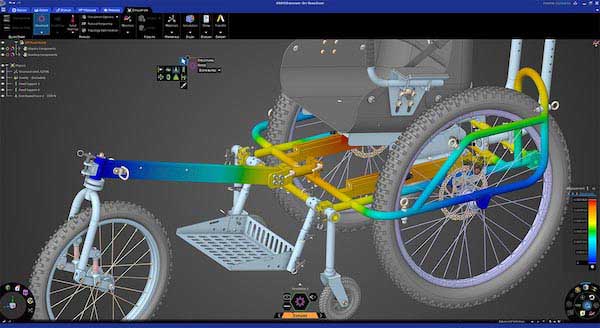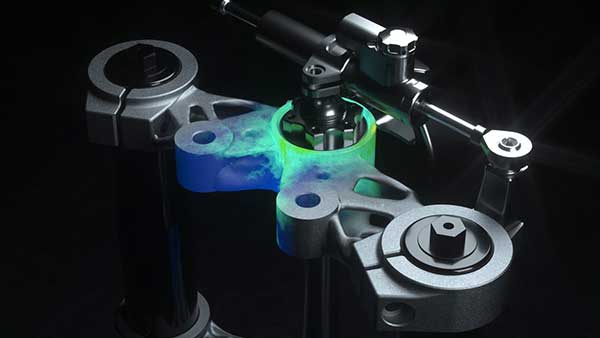Can Generative Design Go Mainstream?
Software vendors have made big investments, but there are barriers to practical adoption.

Ansys Discovery provides near real-time capabilities for generative design applications. Image courtesy of Ansys.
Engineering Resource Center News
Engineering Resource Center Resources


Dell

Latest News
September 18, 2020
Large software vendors in the design space have made heavy investments in generative design technology over the past few years: Ansys, PTC, Autodesk, Altair, MSC Software and others have touted generative as the next frontier of design. But how practical is it? Demonstrations of the technology are very cool to look at, and can produce much lighter and stronger designs, but present a number of hurdles when it comes to manufacturing.
Generative design algorithms often produce membrane-like lattice structures unimaginable to human engineers, and impossible to construct manually in conventional modeling software. Such forms are also impractical to produce using traditional machining. Additive manufacturing is very often the only reasonable means to fabricate those geometries.
IntrinSIM recently launched the intrinSIM Market Report on its assessment of the Autodesk Fusion 360 Generative Design workflow as part of its efforts to help identify where generative design can best be applied. The company plans to produce additional reports that can help companies gauge whether a given generative design solution is applicable for their own operations. The evaluation is based on the suitability assessment framework developed by the ASSESS Initiative.
“Generative design has the potential to dramatically change the design process as we know it. However, deployment of generative design is slow beyond the use by innovators as it is unclear to most if they can use generative design for their application,” says Joe Walsh, CEO of intrinSIM. “This report sets a precedent in the generative design space by establishing a quantitative and objective means to evaluate workflow capabilities and requirements.”
Generative design opens up the possibility of thoroughly exploring the design space and concepts outside of any accumulated proprietary institutional knowledge, according to Walsh. While generative design is not intended to replace detailed design evaluation and analysis, leveraging it early in the process helps reduce the number of design iterations while maximizing the potential to evaluate alternative designs you likely couldn’t explore otherwise, he says.
“Typically what happens is there isn’t a lot of room to innovate in the design decision before it is evaluated against performance requirements,” Walsh says.
Barriers to Adoption
While generative methodologies can help get engineers closer to an optimal design faster, there are a few obstacles. One is compute power. Generative design solutions are complex and need to run in near real time. The technologys algorithm-driven method—running simulations and experimenting with hundreds of design variants to identify the best possible topology—is a compute-intensive process, best executed on highly-parallel GPUs. To make this process “interactive” means to produce the optimized results in near-real-time speed, without subjecting the user to wait for the number crunching. That is why solutions like Creo/Frustum and Ansys Discovery rely on harvesting GPU processing power.
A well-configured workstation and GPU acceleration can enable these solutions, but for some organizations that may require an investment in new hardware or HPC resources.
A more significant problem is one of production capability. While a generative design can create a design that is lighter and stronger, the sometimes wild-looking geometries created cannot be produced in volume using traditional methods.
“You can produce something that is lighter and performs better, but if it has to be produced in volume then additive is a limiting factor,“ says Mike Geyer, industry marketing director at NVIDIA.
In part, this will require a cultural change among engineers using the solutions. So far, many demonstrations of generative design capabilities have focused on the flashy, organic-looking designs that can be created by combining the technology with 3D printing. The parameters fed into these systems should incorporate more specific parameters to take production capabilities into account—if you only have access to a 5-axis CNC machine, there are limits to how far you can go.
Users will need a better understanding of how to set up the problem that needs to be solved (rather than simply defining geometry parameters). That will require a more holistic approach.
“The problem we identified is that by only addressing part of the problem, engineers have come to expect many design ideas from tools where what they need are feasible designs that meet all of their criteria,” says Dr. Thomas Reiher, director, generative design at MSC Software. “We maintain it’s important to support engineers in their daily work by giving them a solution for the whole workflow and not just one aspect.”
There will need to be cultural and organizational changes before generative design can be widely adopted. Walsh says collaboration between simulation experts and design engineers is important to develop confidence in the capabilities. Organizations will also need experts with knowledge of simulation, design, manufacturing requirements, AI, and statistics to fuel a generative design-inspired paradigm shift along with a governance strategy to ensure the right problem is being defined and solved with the right tool set.
“For a full paradigm shift to occur, generative design needs to support a broad range of design scenarios,” Walsh says. “It doesn’t mean it might not be perfect for your application, it just means it’s still not able to enable a full board shift.”
There have been promising developments on the software front that could help increase usage of generative design. Ansys launched Discovery earlier this year, which integrates Discovery Live, Discovery AIM and SpaceClaim. Engineers can change geometries based on rapid feedback, and can see the results of mechanical and fluid simulations in near real time.
PTC has incorporated Frustum into its Creo product to enable designers to leverage the power of AI to quickly produce optimized designs based on their engineering requirements and manufacturing constraints. Through its alliance with Ansys, Creo 7.0 also introduced fluid flow analysis in Creo Simulation Live—a real-time simulation solution that allows designers to iterate faster.
There have also been some interesting use-case demonstrations. Autodesk and Volkswagen fitted a van with some fancy wheels courtesy of generative design, but the project was not targeted at mass production. MX3D, Altair and ABB also produced a 3D-printed robotic arm using generative design, but this was a highly custom application for a replacement part.

MJK Performance used generative design technology to create a set of lighter and stronger triple clamps for a drag bike. Image courtesy of Autodesk.
A more promising example was an Autodesk project with MJK Performance, an aftermarket motorcycle part company. They were able to leverage generative to optimize a clamp produced via 2.5-axis milling. The clamps are 23% lighter at a comparable cost.
That type of decoupling of generative from additive manufacturing will be key for adoption. One possibility: using generative design to create jigs, fixtures, molds or inserts that can be used in other production processes like injection molding.
For example, Danish company AddiFab launched its Freeform Injection Molding solutions, which leverages generative design to enable injection molding of geometries that are too complex for conventional tooling.
“It may be that too much of the software is focused on FEA problems, when it should be focused on CFD problems,“ Geyer says. “The technology could be used to optimize flow for applications like manifolds or conformal cooling in injection molding, rather than making a bracket that is lighter but will take 500-times longer to produce.“
More Dell Coverage

More NVIDIA Coverage
Subscribe to our FREE magazine, FREE email newsletters or both!
Latest News





